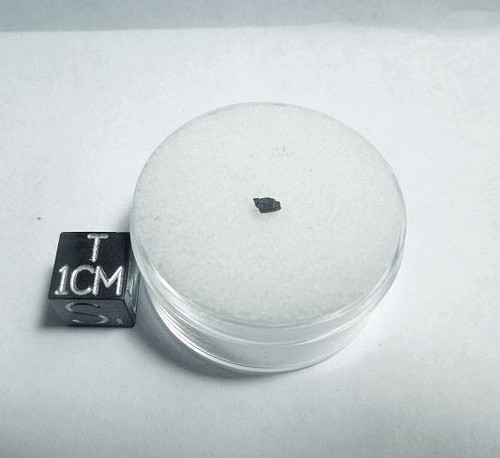Carancas slammed into rural Peru in September 2007. It exploded with a powerful shockwave that damaged homes and knocked people off their feet. The impact was so violent that it carved out a large 30+ feet diameter crater and the entire meteorite was pulverized into tiny fragments and dust - there are very few large chunks of Carancas in existence.
Carancas is a rare H4-5 Chondrite with a concrete gray matrix, metal flecks, and occasional chondrules. Carancas is also a witnessed fall, a hammer fall, and a crater-maker.
Refer to the photo. The black centimeter cube is shown for scale and is not included. You are purchasing a single small fragment selected from the larger lot shown. Your purchase will include a labeled gemjar.
From the Meteoritical Society Bulletin for Carancas :
Carancas 16°39'52''S, 69°02'38''W
Carancas, Chucuito, Puno, Peru
Fall: 15 September 2007, ~16: 45 UTC
Ordinary chondrite (H4-5)
History: A large fireball was witnessed to impact near the community of Carancas, in the province of Chucuito, region of Puno in the country of Peru. It made a sizable impact crater, ~13.8 m in diameter (INGEMMET) or 11-12 m (L. Jackson, CGS). Local residents and many others have recovered numerous pieces of the impactor from the sides of the crater and the surrounding area. Mike Farmer brought several samples to the Lunar and Planetary Laboratory of the UAz for classification on October 5, 2007. The total mass is currently unknown. A preliminary report was published on the web by F. Luisa Macedo and O. José Macharé of Peru.
Physical characteristics: Most specimens are without fusion crust and have a gray color with some metal and chondrules visible, although the chondrules are not easily observed. At least one specimen had two different lithologies, the second white in color, indicating it is a breccia. Numerous black shock veins, often on more than one face of a specimen, were observed. At least one large (~2 cm) metal grain was also recovered, with a thin layer of stone attached to it.





